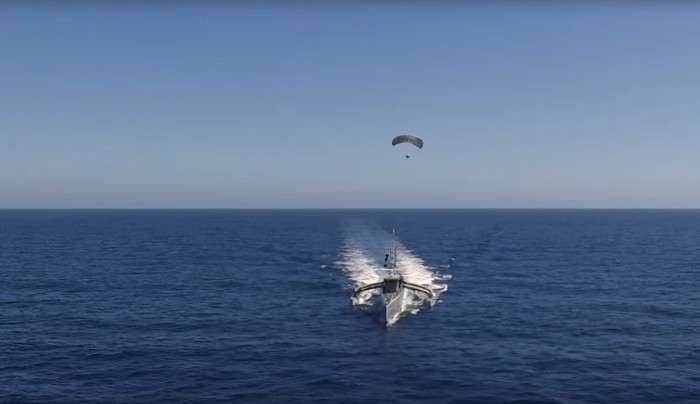DARPA’s Autonomous Ship Is Patrolling the Seas with a Parasailing Radar
California may be the home of Google’s robotic cars, but just off the coast, DARPA is testing technology that puts the search giant’s trundling little autonomous marshmallows to shame.
The defense agency’s robotic ship—the Continuous Trail Unmanned Vessel, to those in the know—has been running sea trials on its new radar system. But the technology doesn’t sit aboard the ship: instead, it’s slung behind it on a parasail in order to reach heights of between 500 and 1,500 feet.

Tests show that the extra altitude boosts the radar’s effectiveness, vastly extending its range beyond what's possible when it’s simply fixed to a ship’s mast. DARPA believes this is what the future of naval warfare looks like: drone boats out patrolling in potentially hostile waters, while manned boats remain out of harm’s way for as long as possible.
DARPA isn’t alone in building robotic ships, though. Between initiatives to develop autonomous taxi boats in Amsterdam, data-collecting trimarans in California, and autonomous tugs in Boston, self-sailing boats are taking to the water all over the world.
(Read more: DARPA, “Fleets of Robotic Boats Are Getting Ready to Set Sail”)
Keep Reading
Most Popular
Large language models can do jaw-dropping things. But nobody knows exactly why.
And that's a problem. Figuring it out is one of the biggest scientific puzzles of our time and a crucial step towards controlling more powerful future models.
The problem with plug-in hybrids? Their drivers.
Plug-in hybrids are often sold as a transition to EVs, but new data from Europe shows we’re still underestimating the emissions they produce.
Google DeepMind’s new generative model makes Super Mario–like games from scratch
Genie learns how to control games by watching hours and hours of video. It could help train next-gen robots too.
How scientists traced a mysterious covid case back to six toilets
When wastewater surveillance turns into a hunt for a single infected individual, the ethics get tricky.
Stay connected
Get the latest updates from
MIT Technology Review
Discover special offers, top stories, upcoming events, and more.